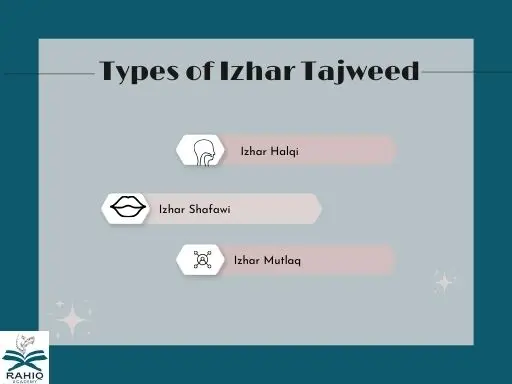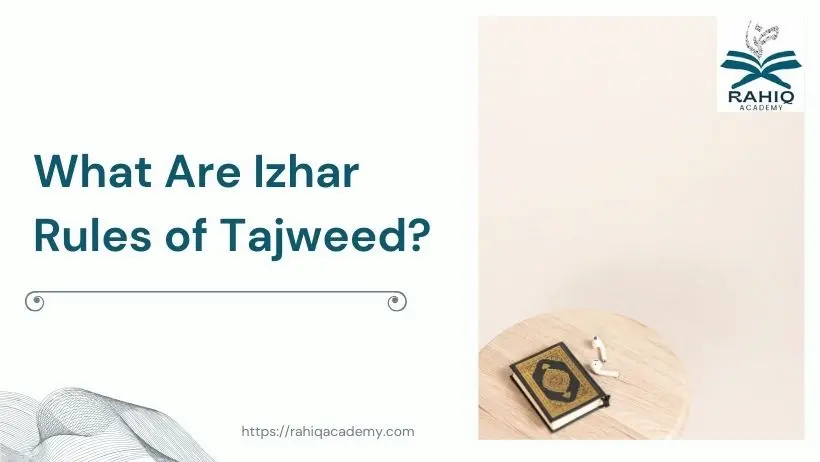The art of reciting the Quran with proper pronunciation and articulation, known as Tajweed, is essential for preserving the beauty and accuracy of Quranic recitation. Among the various Tajweed rules, Izhar is fundamental as it ensures the clear pronunciation of specific letters, preventing any blending or ambiguity in the recitation. In this article, we will explore What Are Izhar Rules of Tajweed? the different aspects of Izhar, its types, and its practical applications in Quranic recitation.
Izhar Tajweed
Izhar Tajweed linguistically means: clarity.
In technical terms, it refers to pronouncing certain letters in specific cases clearly and distinctly without any nasalization (ghunnah). This depends on the Tajweed rule present in the verse. There may be several reasons for Al-Izhar.
We will mention these reasons and types in detail in the upcoming elements.
For example, in the verse:
﴾بَلَىٰ مَنْ أَسْلَمَ وَجْهَهُ لِلَّهِ وَهُوَ مُحْسِنٌ فَلَهُ أَجْرُهُ عِندَ رَبِّهِ وَلَا خَوْفٌ عَلَيْهِمْ وَلَا هُمْ يَحْزَنُونَ ﴿
“whoever submits his face in Islam to Allah while being a doer of good will have his reward with his Lord. And no fear will there be concerning them, nor will they grieve.”
The Noon Sakinah (نْ) is followed by the letter Hamzah (ء), which must be pronounced clearly, ensuring that the Noon is articulated without any blending into the following letter. This precise pronunciation helps maintain the accuracy and beauty of the Quranic recitation.
Types of Izhar Tajweed

Types of Izhar Tajweed is categorized into 3 types based on the different contexts and specific rules of application:
1. Izhar Halqi (إظهار حلقي)
Izhar Halqi is applied when one of the six throat letters follows Noon Sakinah or Tanween. The term “Halqi” indicates that these letters originate from the throat, requiring a clear and distinct pronunciation. This rule ensures that the letters are not merged or nasalized, preserving the clarity of the Quranic text. For example, in the verse:
فَمَنْ خَافَ مِن مُّوصٍ جَنَفًا
“But if one fears from the bequeather [some] error…”
(Surah Al-Baqarah, 2:182)
The Noon Sakinah (نْ) is followed by the letter Kha (خ), and it must be pronounced clearly to fulfill the rule of Izhar Halqi.
Examples will be given for all letters in the following elements.
2. Izhar Mutlaq (إظهار مطلق)
Izhar Mutlaq is a unique Tajweed rule applied in a few specific cases where the letters Waw (و) or Ya (ي) follow Noon Sakinah within the same word, but the sound is not merged. This rule is applied to only four words in the Quran:
- الدُّنْيَا (Ad-Dunya): “The worldly life” (Surah Al-Baqarah, 2:85)
- بُنْيَان (Bunyan): “Structure” (Surah As-Saff, 61:4)
- قِنْوَان (Qinwan): “Clusters” (Surah Al-An’am, 6:99)
- صِنْوَان (Sinwan): “Twins” (Surah Ar-Ra’d, 13:4)
In these instances, the Noon Sakinah is pronounced clearly without merging into the following letter, emphasizing the distinctiveness of the pronunciation.
Izhar Shafawi
Izhar Shafawi (إظهار شفوي) refers to the clear pronunciation of Meem Sakinah (مْ) when followed by any letter except Baa (ب) and Meem (م). The term “Shafawi” is derived from “Shafah” (شفه), meaning “lip,” indicating that this rule involves the articulation of Meem using the lips without any nasalization.
Al-Izhar Al-Shafawi applies to 26 letters, which are all Arabic letters except for the letters Meem and Baa.
Therefore, when there is a Meem Saakinah (م) followed by any letter from the Arabic language except for Meem (م) and Baa (ب), the Meem must be pronounced clearly without any nasalization (ghunnah) or concealment (ikhfa).
Examples will be given for all letters in the following elements.
Izhar Tajweed Letters and examples
1- Izhar Halqi
The six letters that require Izhar are known as the Halaqi letters, as they are articulated from the throat (Halaq). Here is a brief explanation of each letter’s articulation point and characteristics:
1-ء (Hamzah) – Pronounced from the deepest part of the throat, requiring complete closure of the vocal cords, resulting in a distinct, sharp sound.
- Example of Hamza with the noon sakinah in a word:
“وَهُمْ يَنْهَوْنَ عَنْهُ وَيَنْأَوْنَ عَنْهُ ۖ وَإِن يُهْلِكُونَ إِلَّا أَنفُسَهُمْ وَمَا يَشْعُرُونَ”
(Surat Al-An’am, 26)
- Example of Hamza with the noon sakinah in two words:
“وَمَا هُم بِضَارِّينَ بِهِ مِنْ أَحَدٍ إِلَّا بِإِذْنِ اللَّهِ”
(Surat Al-Baqarah, 102)
- Example of Hamza After Tanween:
“وَأَعْتَدْنَا لِلْكَافِرِينَ مِنْهُمْ عَذَابًا أَلِيمًا”
(Surat An-Nisa’, 161 )
2-ه (Ha) – Produced slightly above the Hamzah, with a partial opening of the vocal cords, creating a soft, airy sound.
- Example of Haa with the noon sakinah in a word:
“جَنَّاتٍ تَجْرِي مِن تَحْتِهَا الْأَنْهَارُ ۖ كُلَّمَا رُزِقُوا مِنْهَا مِن ثَمَرَةٍ رِّزْقًا”
(Surat Al-Baaqarah, 25)
- Example of Haa with a noon sakinah in two words:
“وَمَنْ يُضْلِلِ اللَّهُ فَمَا لَهُ مِنْ هَادٍ”
(Surat Al-Ra’d, 33)
- Example of Haa after Tanween:
“سَلَامٌ هِيَ حَتَّىٰ مَطْلَعِ الْفَجْرِ”
(Surat Al-Qadr, 5)
3-ع (‘Ayn) – Articulated from the middle of the throat, requiring moderate constriction of the throat muscles, creating a deep guttural sound.
Examples:
- Example of Ain with the noon sakinah in a word:
“صِرَاطَ الَّذِينَ أَنْعَمْتَ عَلَيْهِمْ غَيْرِ الْمَغْضُوبِ عَلَيْهِمْ وَلَا الضَّالِّينَ”
(Surat Al-Fatiha, 7)
- Example of Ain with the noon sakinah in two words:
“وَلَوْ أَنَّهُمْ آمَنُوا وَاتَّقَوْا لَمَثُوبَةٌ مِّنْ عِندِ اللَّهِ خَيْرٌ ۖ لَّوْ كَانُوا يَعْلَمُونَ ”
(Surat Al-Baqarah, 103)
- Example of Ain After tanwen:
“مَّا يَفْعَلُ اللَّهُ بِعَذَابِكُمْ إِن شَكَرْتُمْ وَآمَنتُمْ ۚ وَكَانَ اللَّهُ شَاكِرًا عَلِيمًا”
(Surat An-Nisa, 147)
4-ح (Ha) – Also pronounced from the middle of the throat but softer and more breathy than ‘Ayn, involving less tension in the throat.
Examples:
- Example of Haa with the noon sakinah in a word:
“فَصَلِّ لِرَبِّكَ وَانْحَرْ”
(Surat Al-Kauthar, 2)
- Example of Haa with the noon sakinah in two words:
“وَمِنْ حَيْثُ خَرَجْتَ فَوَلِّ وَجْهَكَ شَطْرَ الْمَسْجِدِ الْحَرَامِ”
(Surat Al-Baqarah, 149)
- Example of Haa After Tanween:
“إِنَّ اللَّهَ كَانَ عَلِيمًا حَكِيمًا”
(Surat An-Nisa, 11)
5-غ (Ghayn) – Produced from the upper throat, involving the back of the tongue and a partial closure, creating a resonant, vibrating sound.
- Example of Ghin with the noon sakinah in a word:
“فَسَيُنْغِضُونَ إِلَيْكَ رُؤُسَهُمْ”
(Surat Al-Israa, 51)
- Example of Ghin with the noon sakinah in two words
“وَنَزَعْنَا مَا فِي صُدُورِهِم مِّنْ غِلٍّ إِخْوَانًا عَلَىٰ سُرُرٍ مُّتَقَابِلِينَ”
(Surat Al-Hijr, 47)
- Examples of Ghin After Tanween:
“وَنَجَّيْنَاهُم مِّنْ عَذَابٍ غَلِيظٍ”
(Surat Hud, 58)
6-خ (Kha) – Pronounced from the same area as Ghayn but with more constriction, resulting in a harsh, guttural sound.
Examples:
- Example of Kha with the noon sakinah in a word
“وَالْمُنْخَنِقَةُ وَالْمَوْقُوذَةُ”
(Surat Al-Ma’idah, 3)
- Example of Khaa with the noon sakinah in two words:
“الَّذِي أَطْعَمَهُم مِّن جُوعٍ وَآمَنَهُم مِّنْ خَوْفٍ”
(Surat Quraysh, 4)
- After Tanween:
“إِنَّ اللَّهَ كَانَ عَلِيمًا خَبِيرًا”
(Surat An-Nisa, 35).
2- Izhar Mutlaq
Izhar Mutlaq is a special rule applied to specific words in the Quran where Noon Sakinah is followed by Waw (و) or Ya (ي) within the same word, and the sound must be pronounced clearly without merging. This rule emphasizes the unique pronunciation required for these cases, ensuring the distinct articulation of the Noon Sakinah.
Examples of Izhar Mutlaq:
There are only four words in the Quran that always follow the rule of Izhar Mutlaq:
- بُنْيَانٌ
- قِنْوَانٌ
- صِنْوَانٌ
- الدنيا
Here are some Ayat where these words are pronounced with Izhar Mutlaq in Quran:
- “إِنَّ اللَّهَ يُحِبُّ الَّذِينَ يُقَاتِلُونَ فِي سَبِيلِهِ صَفًّا كَأَنَّهُم بُنْيَانٌ مَّرْصُوصٌ” (As-Saf, 4)
- “وَمِنَ النَّخْلِ مِن طَلْعِهَا قِنْوَانٌ دَانِيَةٌ وَجَنَّاتٍ مِّنْ أَعْنَابٍ وَالزَّيْتُونَ وَالرُّمَّانَ مُشْتَبِهًا وَغَيْرَ مُتَشَابِهٍ”
- “وَفِي الْأَرْضِ قِطَعٌ مُّتَجَاوِرَاتٌ وَجَنَّاتٌ مِّنْ أَعْنَابٍ وَزَرْعٌ وَنَخِيلٌ صِنْوَانٌ وَغَيْرُ صِنْوَانٍ يُسْقَى بِمَاءٍ وَاحِدٍ” (Al-Ra’d, 4)
- “أُولَٰئِكَ الَّذِينَ اشْتَرَوُا الْحَيَاةَ الدُّنْيَا بِالْآخِرَةِ ۖ فَلَا يُخَفَّفُ عَنْهُمُ الْعَذَابُ وَلَا هُمْ يُنصَرُون”
(Surat Al-Baqarah, 86).
3- Izhar Shafawi
As we mentioned before, Al-Izhar Al-Shafawi applies to 26 letters, which are all Arabic letters except for the letters Meem and Baa.
Let’s practice pronouncing Izhar Shafawi using these Quranic examples with:
- “الْحَمْدُ لِلَّهِ رَبِّ الْعَالَمِينَ” (Surat Al-Fatiha, 2)
- “أَلَمْ يَجْعَلْ كَيْدَهُمْ فِي تَضْلِيلٍ” (Surat Alfeel, 2)
- “لَكُمْ دِينُكُمْ وَلِيَ دِينِ” (Surat Al-Kafroon, 6)
- “إِنَّمَا نُطْعِمُكُمْ لِوَجْهِ اللَّهِ لَا نُرِيدُ مِنكُمْ جَزَاءً وَلَا شُكُورًا” (Surat Al-Insan, 9)
Conclusion
Mastering the various rules of Izhar—Izhar Halqi, Izhar Shafawi, and Izhar Mutlaq—is crucial for anyone seeking to perfect their Quranic recitation. These rules ensure that each letter is pronounced clearly and distinctly, preserving the linguistic beauty and the intended meaning of the Quranic text.
To gain a deeper understanding and mastery of these Tajweed rules, consider enrolling in one of the specialized courses offered by RAHIQ Academy.
Whether you wish to perfect your Tajweed skills through our Quran Tajweed Course, improve your recitation with the Online Quran Recitation Classes, or embark on a journey of Quran memorization with our Quran Memorization Courses, RAHIQ Academy provides the resources and guidance you need to connect deeply with the words of Allah and recite the Quran with accuracy and reverence.




